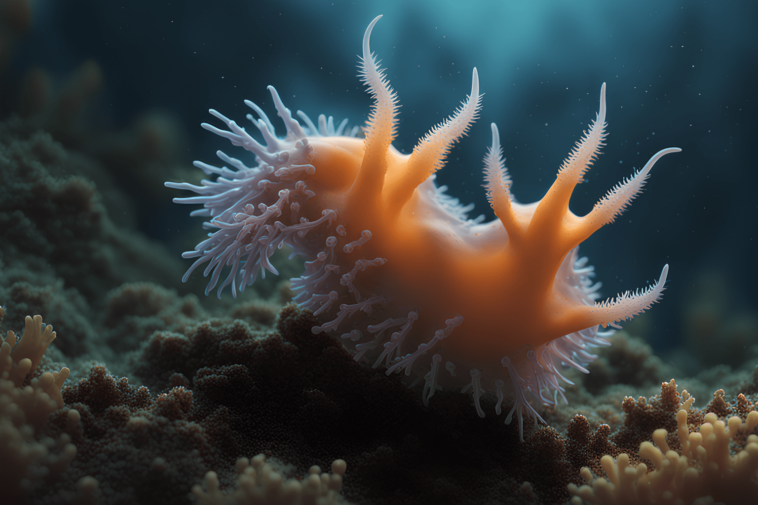Introduction – Diving with Nudibranchs
Imagine descending into the mesmerizing underwater world, where vibrant colors and intricate patterns come to life. Among the myriad of marine creatures that grace the ocean depths, there is a group of creatures that captivate divers and underwater enthusiasts with their stunning beauty and fascinating behavior: nudibranchs. These enigmatic creatures, also known as sea slugs, have become a sought-after sight for divers around the globe.
In this article, we will delve into the captivating realm of diving with nudibranchs. We will explore their physical characteristics, behavioral patterns, and social structures. Moreover, we will provide valuable insights into how to interact with these delicate creatures responsibly and share essential tips for preparing and conducting a memorable nudibranch dive. So, fasten your wetsuit, adjust your mask, and join us as we embark on an unforgettable underwater adventure with nudibranchs.
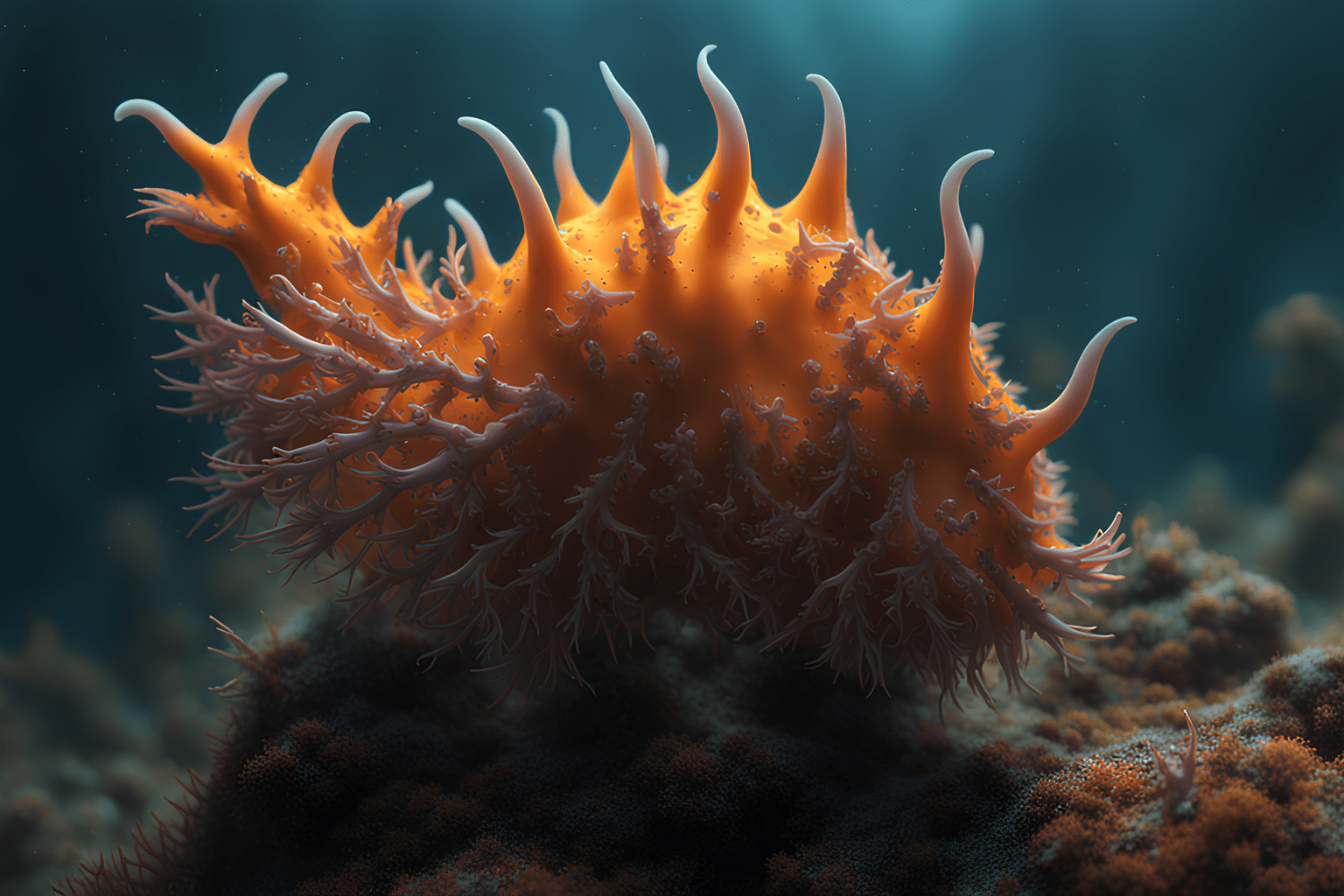
What are Nudibranchs? – Physical Characteristics and Distinguishing Features of Nudibranchs
Nudibranchs, belonging to the scientific class Gastropoda, are a diverse group of marine gastropods that exhibit an astonishing array of colors, shapes, and patterns. Derived from the Latin word “nudus” meaning naked, and “branchia” referring to gills, the name “nudibranch” perfectly captures their unique anatomical feature – exposed gills.
These captivating creatures can be found in oceans worldwide, from tropical reefs to cold-water environments, and are a testament to the incredible diversity of life beneath the waves. While there are over 3,000 known species of nudibranchs, each with its own distinct characteristics, they share several common physical traits.
One of the most striking features of nudibranchs is their colorful and ornate exteriors. Their vibrant hues, ranging from electric blues and fiery oranges to delicate pinks and striking yellows, serve as both a form of camouflage and a warning to potential predators. These dazzling colors are often a result of the nudibranchs’ diet, as they extract pigments from the sponges, hydroids, and other organisms they consume.
The shape and size of nudibranchs can vary significantly. Some species are relatively small, measuring only a few centimeters in length, while others can reach impressive sizes of up to 60 centimeters. Their bodies are typically elongated and cylindrical, with a soft and flexible texture that allows them to navigate through crevices and coral reefs with ease.
One distinguishing feature of nudibranchs is the presence of rhinophores. These sensory structures, located on the nudibranchs’ heads, resemble small horns or antennae. The rhinophores play a crucial role in detecting chemicals in the water, helping the nudibranchs locate food sources, mates, and potential threats. By constantly waving their rhinophores, nudibranchs can gather vital information about their surroundings.
In addition to their rhinophores, nudibranchs often possess other appendages that contribute to their unique appearance. Some species boast extravagant cerata, finger-like projections that extend from their bodies. These cerata serve multiple functions, including respiration, defense, and sometimes even acting as camouflage by resembling the organisms they feed on.
While nudibranchs exhibit an incredible array of physical characteristics, it’s important to note that they are not only visually captivating but also possess intriguing biological adaptations. These adaptations allow them to thrive in diverse environments, and their fascinating behaviors further enhance their allure to divers and marine enthusiasts.
Nudibranchs Behavioral Patterns and Social Structure
Beneath the waves, nudibranchs display a fascinating array of behavioral patterns and exhibit various social structures. While some species are solitary creatures, others engage in complex interactions with their surroundings and fellow nudibranchs.
One remarkable behavior observed among nudibranchs is their feeding habits. These gastropods are predominantly carnivorous, preying on an assortment of organisms such as sponges, hydroids, anemones, and even other nudibranchs. Some species have developed specialized adaptations to acquire and utilize toxic chemicals from their food sources, making them distasteful or even toxic to potential predators. This defensive mechanism provides them with a greater chance of survival in the harsh marine environment.
Nudibranchs also exhibit interesting mating rituals. Most species are hermaphrodites, possessing both male and female reproductive organs. When two nudibranchs come into contact, they engage in a mesmerizing courtship dance, intertwining their bodies and exchanging sperm packets. This unique mating process allows each individual to both give and receive genetic material, maximizing their chances of successful reproduction.
In some species, nudibranchs demonstrate a fascinating form of behavior known as “farming.” These nudibranchs cultivate colonies of photosynthetic organisms, such as zooxanthellae or diatoms, on their cerata or body surface. By actively maintaining and protecting these symbiotic organisms, nudibranchs ensure a constant food source, as they can extract nutrients through photosynthesis. This mutually beneficial relationship highlights the intricate connections within marine ecosystems.
While nudibranchs are often solitary creatures, some species display aggregative behavior. Under certain conditions, nudibranchs can congregate in large numbers, creating mesmerizing displays of colors and patterns. These aggregations may serve various purposes, such as enhancing mating opportunities, seeking protection from predators, or gathering around abundant food sources. Witnessing a gathering of nudibranchs is a spectacle that divers cherish, as it showcases the diversity and social dynamics of these captivating creatures.
Understanding the behavioral patterns and social structure of nudibranchs allows divers to appreciate their interactions within the marine environment. It is important, however, to approach these creatures with care and respect, as their delicate bodies and habitats require preservation.
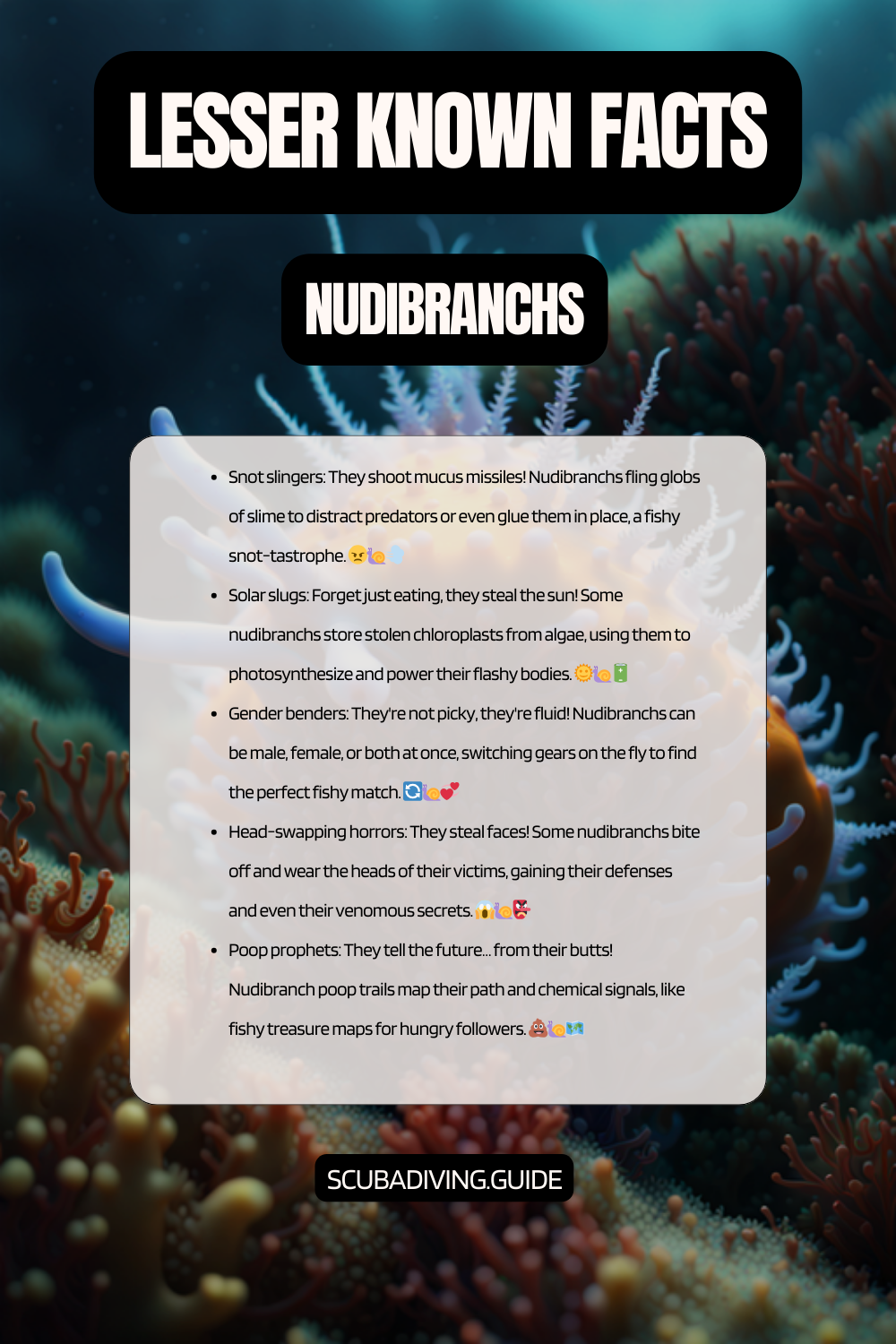
Interacting with Nudibranchs
When diving with nudibranchs, it is essential to approach these delicate creatures with care and respect. Here are some guidelines for responsible interaction with nudibranchs:
- Observe, but do not disturb: Nudibranchs are sensitive creatures, and any excessive touching or handling can harm them. Instead, maintain a safe distance and observe their behavior from a respectful distance.
- Avoid flash photography: Some species of nudibranchs are sensitive to bright lights, including camera flashes. The sudden burst of light can startle or stress the creatures. If you wish to photograph nudibranchs, use natural lighting or underwater photography techniques that minimize disturbance.
- Be mindful of buoyancy: Maintain neutral buoyancy and avoid accidentally bumping into nudibranchs or their surrounding environment. Proper buoyancy control allows you to glide effortlessly without causing harm to these fragile organisms or disturbing the underwater ecosystem.
- Do not remove or collect nudibranchs: It is important to leave these creatures in their natural habitat. Removing nudibranchs from their environment disrupts the delicate balance of marine ecosystems and can have detrimental effects on their populations.
- Share knowledge, not locations: When discussing nudibranch sightings, it is crucial to refrain from disclosing specific dive sites or exact locations. Protecting their habitats from overexploitation and disturbance ensures the long-term preservation of these fascinating creatures.
- Report unusual behavior or sightings: If you come across any unusual behavior or observe rare species of nudibranchs, report your findings to local marine conservation organizations or research institutions. Your observations can contribute to scientific knowledge and aid in the protection of these unique creatures.
Remember, responsible interaction with nudibranchs is essential to safeguard their well-being and preserve their habitats for future generations of divers to enjoy. By following these guidelines, we can ensure the continued existence and appreciation of these remarkable marine organisms.
Preparing for a Nudibranchs Dive
Diving with nudibranchs offers a unique opportunity to witness the beauty of these fascinating creatures up close. To make the most of your nudibranch dive, it is essential to be well-prepared. Here are some key steps to ensure a successful and enjoyable experience:
- Research dive locations: Nudibranchs can be found in various parts of the world, each with its own unique species and habitats. Research different dive destinations known for their nudibranch populations and choose a location that aligns with your preferences and level of diving experience.
- Consult local experts: Reach out to local dive operators, marine biologists, or experienced divers who have knowledge of the area. They can provide valuable insights on the best dive sites, optimal times for nudibranch sightings, and any specific considerations for diving in that region.
- Obtain the necessary certifications: Ensure that you possess the appropriate diving certifications and experience for the dive conditions you will encounter. If you are planning to explore deeper waters or engage in specialized nudibranch research dives, additional training and certifications may be required.
- Pack the right gear: Prioritize your diving gear to optimize your nudibranch experience. A well-fitting wetsuit or drysuit, mask, snorkel, fins, and weight system are essential. Consider using underwater photography or videography equipment if you wish to capture the vibrant colors and intricate details of the nudibranchs.
- Learn about local regulations: Familiarize yourself with any local regulations or guidelines pertaining to diving in the area. Some marine protected areas or dive sites may have specific rules regarding interaction with marine life or restrictions on certain diving practices. Adhering to these regulations helps preserve the marine environment and ensures sustainable diving practices.
- Brush up on underwater photography techniques: If you plan to document your nudibranch encounters through photography, take the time to learn and practice underwater photography techniques. Familiarize yourself with the settings and features of your camera, as well as composition and lighting techniques to capture stunning images.
- Stay updated on dive conditions: Before heading out for a nudibranch dive, stay informed about current dive conditions, weather patterns, and any potential hazards. Check with local dive operators or consult reliable sources for the most up-to-date information. Being aware of these factors enhances your safety and overall diving experience.
By taking the necessary steps to prepare for your nudibranch dive, you can ensure a rewarding and memorable underwater adventure. Remember to approach the dive with a sense of wonder and respect for the marine environment, and be ready to immerse yourself in the incredible world of nudibranchs.
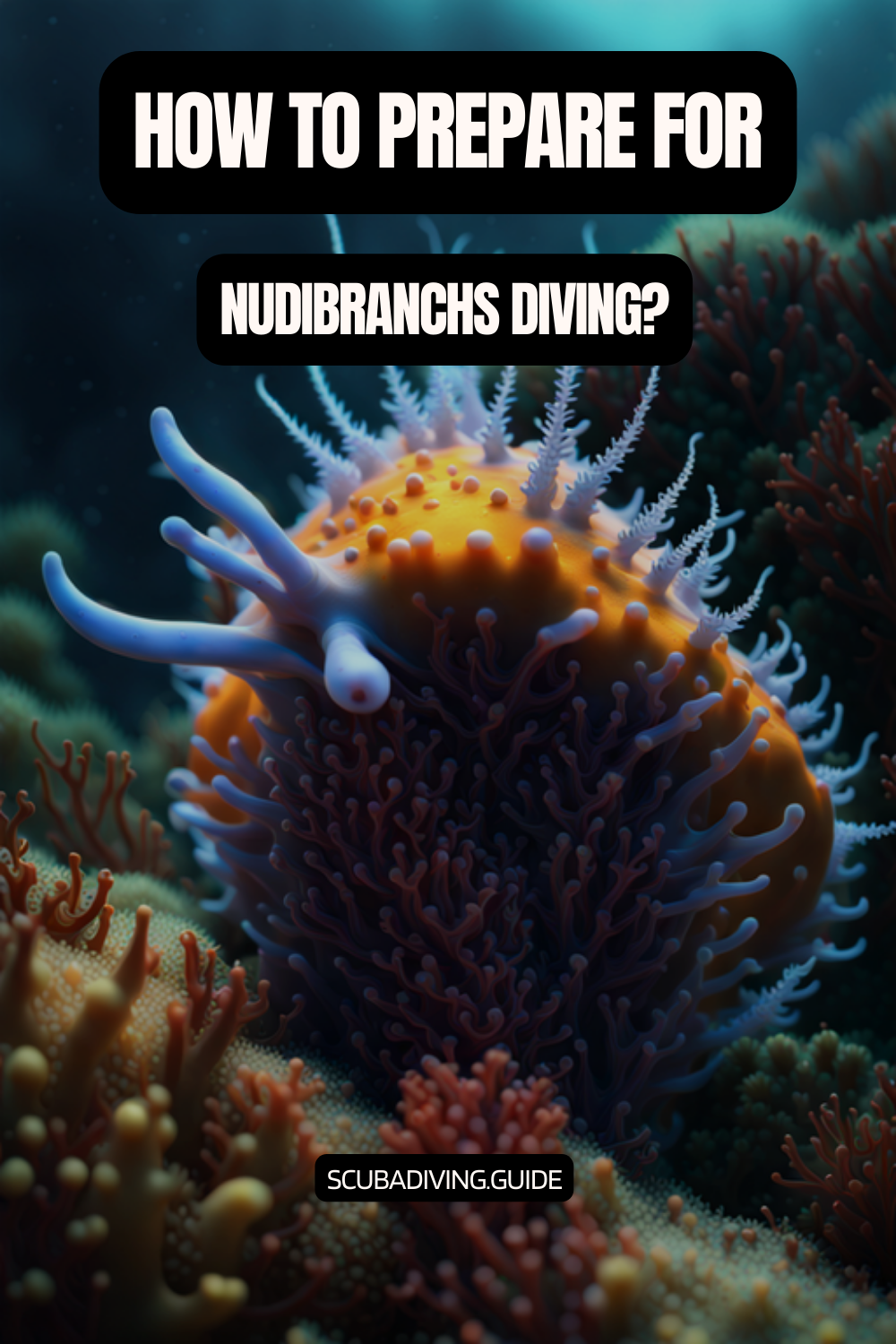
Diving Techniques for Diving with Nudibranchs
To fully appreciate the beauty and intricacy of nudibranchs, it is important to employ appropriate diving techniques. Here are some diving techniques that can enhance your experience when diving with these captivating creatures:
- Slow and methodical approach: Nudibranchs are often found in small crevices, on coral reefs, or among seagrass beds. Approach these areas slowly and cautiously, maintaining good buoyancy control. Take your time to scan the surroundings carefully, as nudibranchs can blend in with their environment due to their vibrant colors and intricate patterns.
- Buoyancy control: Mastering buoyancy control is crucial for diving with nudibranchs. Practice maintaining neutral buoyancy to avoid accidentally damaging the delicate organisms or disturbing the sediment. Avoid touching the seafloor or surrounding structures, as this can stir up sediment and reduce visibility.
- Use hand signals: Communication underwater is essential, especially when diving with a buddy or dive guide. Establish and review hand signals before the dive to facilitate effective communication about nudibranch sightings or any other points of interest. This ensures that you can share your excitement without disturbing the natural behavior of the nudibranchs.
- Employ macro diving techniques: Nudibranchs are often small and intricate, requiring a macro diving approach to fully appreciate their beauty. Use a macro lens or a camera with a macro setting to capture detailed images of the nudibranchs and their unique features. Get close to your subject, but remember to do so without causing any harm.
- Be patient and observant: Nudibranchs can be elusive and may take some time to locate. Exercise patience and keep a keen eye for subtle movements or vibrant colors that may indicate their presence. Take the time to observe their behavior, feeding habits, and interactions with their environment. The more you observe, the more you will learn about these fascinating creatures.
- Dive during optimal times: Some nudibranch species are more active during certain times of the day or year. Research the behavior and habitat preferences of the nudibranchs in the area you plan to dive. This knowledge can help you choose the best times to dive for increased chances of encountering these remarkable creatures.
- Dive with an experienced guide: If you are new to nudibranch diving or exploring unfamiliar dive sites, consider diving with an experienced guide. They possess extensive knowledge of the local marine life and can help you locate nudibranchs and identify different species. Additionally, a guide can provide valuable insights into nudibranch behavior and point out hidden gems that you might otherwise miss.
By employing these diving techniques, you can maximize your chances of encountering nudibranchs, appreciate their intricate details, and contribute to their conservation by ensuring minimal disturbance during your dives.
Essential Gear for Diving with Nudibranchs
When embarking on a diving adventure to explore the vibrant world of nudibranchs, having the right gear can enhance your experience and ensure your safety. Here are some essential pieces of gear to consider when diving with nudibranchs:
- Mask and Snorkel: A properly fitting mask and snorkel are essential for clear vision and comfortable breathing at the surface. Choose a mask that provides a wide field of view and a snug, leak-free fit. Opt for a snorkel that is comfortable to use and has a purge valve to easily clear water if it enters the snorkel.
- Wetsuit or Drysuit: The choice between a wetsuit or drysuit depends on the water temperature at your diving location. In colder waters, a drysuit provides insulation and keeps you dry, while a wetsuit is suitable for warmer waters. Choose a wetsuit or drysuit that fits well and allows for freedom of movement.
- Fins: Fins provide propulsion and maneuverability underwater. Opt for fins that fit comfortably and offer the right amount of stiffness for your diving style. Consider open-heel fins that can be worn with dive boots for added comfort and protection.
- Dive Computer: A dive computer is an essential piece of equipment that monitors your dive profile, tracks bottom time, and provides important safety information, such as decompression limits and ascent rates. Choose a dive computer that suits your diving needs and preferences.
- Underwater Camera: Capturing the vibrant colors and intricate details of nudibranchs is a joyous experience. Invest in an underwater camera or housing that is suitable for your skill level and budget. Consider a macro lens or a camera with macro capabilities to capture the small, intricate features of nudibranchs.
- Dive Light: Nudibranchs can often be found in crevices or hidden among coral reefs. A dive light is invaluable for illuminating dark areas and bringing out the vivid colors of these creatures. Choose a dive light with a wide beam angle and a brightness level appropriate for the depth and conditions of your dives.
- Cutting Tool: Carrying a cutting tool, such as a dive knife or shears, is recommended for safety purposes. It can be used to free yourself from entanglements or to remove fishing lines or other debris that may pose a risk to the nudibranchs or other marine life.
- Surface Marker Buoy (SMB): An SMB is a valuable tool for signaling your location to surface support and other divers. Deploying an SMB at the end of your dive helps ensure your safety and alerts boats or other watercraft to your presence in the water.
Remember, the gear mentioned above is just a starting point. Always consult with local dive professionals and consider the specific conditions and requirements of your dive location to ensure you have the appropriate gear for a safe and enjoyable nudibranch diving experience.
Nudibranchs Safety Tips and Emergency Procedures
While diving with nudibranchs is an exciting and rewarding experience, it’s important to prioritize safety and be prepared for any unforeseen circumstances. Here are some safety tips and emergency procedures to keep in mind when diving with these captivating creatures:
- Dive within your limits: Always dive within your certified limits and personal experience level. Nudibranchs can be found at various depths, but it’s crucial to have the necessary training and experience to handle the conditions you encounter. If you’re not certified for deep or technical diving, avoid diving beyond your comfort zone.
- Buddy system: Never dive alone. Always dive with a buddy and maintain visual contact throughout the dive. Having a buddy provides an additional layer of safety and allows for immediate assistance in case of an emergency.
- Plan your dive, dive your plan: Before entering the water, plan your dive with your buddy. Discuss the dive site, depth, duration, and communication signals. Establish a maximum depth and bottom time to ensure a safe ascent and minimize the risk of decompression sickness.
- Monitor your air supply: Keep a close eye on your air supply throughout the dive. Monitor your pressure gauge regularly and plan your dive to allow for a safe ascent with an appropriate reserve of air.
- Practice good buoyancy control: Proper buoyancy control is crucial when diving with nudibranchs. Avoid touching or damaging the delicate organisms or disturbing the surrounding environment. Maintain neutral buoyancy and make slow, deliberate movements to minimize any impact.
- Equalize your ears: Equalize your ears regularly during descent to prevent discomfort or injury. Clear your ears gently and frequently to ensure equalization, especially when diving to greater depths.
- Be aware of your surroundings: Stay alert and be mindful of potential hazards such as strong currents, sharp coral, or other marine life that may pose a threat. Avoid contact with venomous organisms and give them ample space to avoid accidental encounters.
- Emergency procedures: Familiarize yourself with emergency procedures and communication signals before the dive. Ensure you know how to communicate distress, conduct an emergency ascent, and perform basic first aid techniques. Be prepared to assist your buddy and seek immediate medical attention if needed.
- Follow local regulations: Respect and follow local diving regulations and guidelines. These regulations are in place to protect the marine environment, including the nudibranchs and their habitats. Avoid damaging or removing any marine life, and report any illegal or harmful activities you may witness.
- Stay updated on safety practices: Stay informed about the latest diving safety practices and recommendations. Participate in refresher courses or continuing education to enhance your diving skills and knowledge.
Remember, safety should always be your top priority when diving with nudibranchs. By following these safety tips and being prepared for emergencies, you can have a safe and enjoyable experience while exploring the mesmerizing world of these captivating creatures.
Thrills and Challenges of Diving with Nudibranchs
Diving with nudibranchs presents both thrills and challenges that make each underwater encounter a truly unique experience. Here are some of the exhilarating aspects and potential difficulties associated with diving with these captivating creatures:
- Visual Spectacle: One of the greatest thrills of diving with nudibranchs is the visual spectacle they provide. Their vibrant colors and intricate patterns create a mesmerizing underwater display. Witnessing a nudibranch’s radiant hues amidst the backdrop of the ocean is a feast for the eyes and a source of wonder for divers.
- Macro Photography Opportunities: Nudibranchs offer incredible opportunities for macro photography enthusiasts. Their intricate details, textures, and vibrant colors make for stunning close-up shots. Capturing these tiny creatures with their unique features can be immensely rewarding, allowing divers to share their encounters with others.
- Biodiversity Exploration: Diving with nudibranchs often means exploring diverse and rich ecosystems. As you search for these remarkable creatures, you’ll likely encounter a plethora of other marine species. Exploring their habitats and observing the interconnectedness of the underwater world adds depth to the overall diving experience.
- Constant Learning: Nudibranchs are a diverse group with thousands of species yet to be fully documented. Each dive offers an opportunity to learn about new species, their behaviors, and their ecological significance. The thrill of discovery and expanding your knowledge of the marine world is an ongoing journey when diving with nudibranchs.
- Camouflage and Elusiveness: One of the challenges when diving with nudibranchs is their remarkable ability to camouflage themselves. They often blend seamlessly into their surroundings, making them difficult to spot. The thrill lies in the excitement of finding these elusive creatures hidden among coral reefs, rocks, or seagrass beds.
- Fragile Nature: Nudibranchs are delicate creatures, and it is important to exercise caution to avoid unintentional harm. Their fragile bodies and habitats require careful navigation and a respectful approach to minimize disturbances. The challenge lies in maintaining good buoyancy control and ensuring responsible interaction without causing damage.
- Limited Encounter Time: Nudibranchs can be elusive and may not stay in one place for long. They might crawl slowly or drift with currents, making it challenging to observe them for an extended period. Patience and keen observation skills are necessary to fully appreciate and capture their beauty during limited encounter times.
- Environmental Awareness: Diving with nudibranchs raises awareness about the fragility and conservation needs of marine ecosystems. Witnessing these captivating creatures in their natural habitat encourages divers to become advocates for marine conservation. The challenge lies in translating the awe and respect experienced underwater into actions that protect these environments for future generations.
Diving with nudibranchs is a thrilling adventure that combines visual beauty, exploration, and a deeper understanding of marine life. While it comes with its challenges, the rewards of encountering these captivating creatures in their natural habitats are immeasurable, leaving divers with lasting memories and a desire to protect the fragile ecosystems they call home.
Common Marine Species Found Alongside Nudibranchs
Diving with nudibranchs often provides an opportunity to encounter a variety of marine species that coexist in the same habitats. These diverse ecosystems teem with life, and alongside nudibranchs, you may encounter the following common marine species:
- Corals: Coral reefs are vibrant and bustling habitats that serve as a home for numerous species. Hard corals, soft corals, and colorful coral formations provide a stunning backdrop to nudibranch encounters. These coral structures support a wealth of marine life, including fish, crustaceans, and other invertebrates.
- Fish: Nudibranch dives often offer encounters with a wide array of fish species. Schools of vibrant reef fish, such as clownfish, angelfish, butterflyfish, and wrasses, can be observed darting in and out of coral formations. Larger predatory fish, including groupers and barracudas, may also roam the area, drawn to the abundance of marine life.
- Sea Anemones: Nudibranchs and sea anemones often have a symbiotic relationship. Some nudibranch species have developed immunity to the stinging cells of sea anemones, allowing them to feed on the anemones’ tentacles without harm. It is not uncommon to find nudibranchs nestled among the protective arms of sea anemones.
- Sea Stars: Sea stars, also known as starfish, can be found in a variety of shapes, colors, and sizes. These echinoderms slowly move across the seafloor, using their tube feet to navigate. Some nudibranch species, such as the colorful Dendrodoris, can often be seen crawling near or on sea stars.
- Crustaceans: Diving with nudibranchs provides opportunities to encounter various crustaceans, including shrimp, crabs, and lobsters. These fascinating creatures often inhabit crevices and coral formations, making them exciting finds during a nudibranch dive. Watch closely, as tiny cleaner shrimp may be found perched on the nudibranchs themselves.
- Sea Cucumbers: These cylindrical and elongated echinoderms, known as sea cucumbers, can be found resting on the seafloor or slowly crawling along. While not as visually striking as nudibranchs, sea cucumbers play an important role in marine ecosystems by recycling organic matter and maintaining sediment balance.
- Sponges: Nudibranchs often feed on sponges, making them common companions in the underwater world. Sponges come in a variety of shapes, sizes, and colors, providing an intricate landscape for nudibranch encounters. These filter-feeding organisms serve as vital components of marine ecosystems, providing habitats for other species.
- Hydroids: Hydroids, small and delicate creatures related to jellyfish and corals, are another common sight during nudibranch dives. They often resemble tiny, branching structures that protrude from rocks or coral, and some nudibranch species feed exclusively on hydroids.
Encountering these common marine species alongside nudibranchs adds depth and richness to your underwater experience. Each organism plays a vital role in the intricate web of life, creating a harmonious ecosystem that supports the beauty and diversity of the marine world.
Best Destinations for Diving with Nudibranchs
Exploring the world of nudibranchs is a thrilling endeavor that can take you to some of the most breathtaking dive destinations around the globe. Here is a list of the best destinations, separated by regions, where you can encounter an abundance of nudibranch species:
- Asia:
- Indonesia: The diverse dive sites of Indonesia, including Raja Ampat, Komodo National Park, and Lembeh Strait, offer incredible nudibranch encounters in a variety of underwater environments.
- Philippines: Popular dive destinations like Anilao, Puerto Galera, and Moalboal provide rich biodiversity and numerous nudibranch species to discover.
- Malaysia: Sipadan Island, Mabul, and the surrounding dive sites in Malaysian Borneo are known for their vibrant marine life, including a wide array of nudibranchs.
- Japan: The waters surrounding Japan, particularly the Osezaki area in Izu Peninsula and the Kerama Islands in Okinawa, are home to diverse nudibranch populations.
- Africa:
- South Africa: The reefs of Sodwana Bay and the Aliwal Shoal are renowned for their abundance of nudibranch species, making them prime diving locations.
- Mozambique: The waters of Mozambique, particularly in Tofo Beach and the Bazaruto Archipelago, offer opportunities to encounter a wide variety of nudibranchs.
- Caribbean:
- Bonaire: This Dutch Caribbean island is famous for its pristine marine environment, with sites like the Bonaire National Marine Park offering ample nudibranch sightings.
- Dominica: The volcanic island of Dominica boasts thriving reefs where nudibranchs can be found, particularly around the Soufriere-Scotts Head Marine Reserve.
- Central America:
- Costa Rica: Cocos Island, a UNESCO World Heritage Site, is known for its incredible biodiversity, including a rich nudibranch population. Additionally, sites like Manuel Antonio and the Gulf of Papagayo offer excellent diving opportunities.
- Belize: The Belize Barrier Reef, the second-largest reef system in the world, is home to a plethora of nudibranch species. Areas such as Ambergris Caye and the Turneffe Atoll are popular dive spots.
- Europe:
- Spain: The Mediterranean coast of Spain, including the Costa Brava and Costa del Sol, is known for its vibrant nudibranch populations and diverse marine life.
- Italy: The waters around the island of Sardinia, particularly the Marine Protected Area of Tavolara, offer fantastic diving experiences with abundant nudibranch sightings.
- Oceania:
- Australia: The Great Barrier Reef, with its extensive reef system, provides numerous dive sites where nudibranchs can be found. Locations like the Ribbon Reefs and the Cod Hole are popular for nudibranch enthusiasts.
- Papua New Guinea: The waters of Papua New Guinea, including the Milne Bay region and Kimbe Bay, are known for their incredible biodiversity and nudibranch diversity.
- North America:
- California, USA: The California coast, from Monterey to San Diego, offers a range of dive sites where nudibranchs can be spotted, such as the kelp forests of Monterey Bay.
- British Columbia, Canada: The cold waters of British Columbia are home to a variety of nudibranch species, particularly around Vancouver Island and the Sunshine Coast.
- South America:
- Galapagos Islands, Ecuador: The Galapagos Islands, a UNESCO World Heritage Site, provide exceptional diving experiences with unique nudibranch species and an abundance of marine life.
These destinations offer remarkable opportunities to explore the world of nudibranchs and dive into vibrant marine ecosystems. Remember to research local diving regulations, seasons, and conditions before planning your trip to ensure the best possible diving experience.
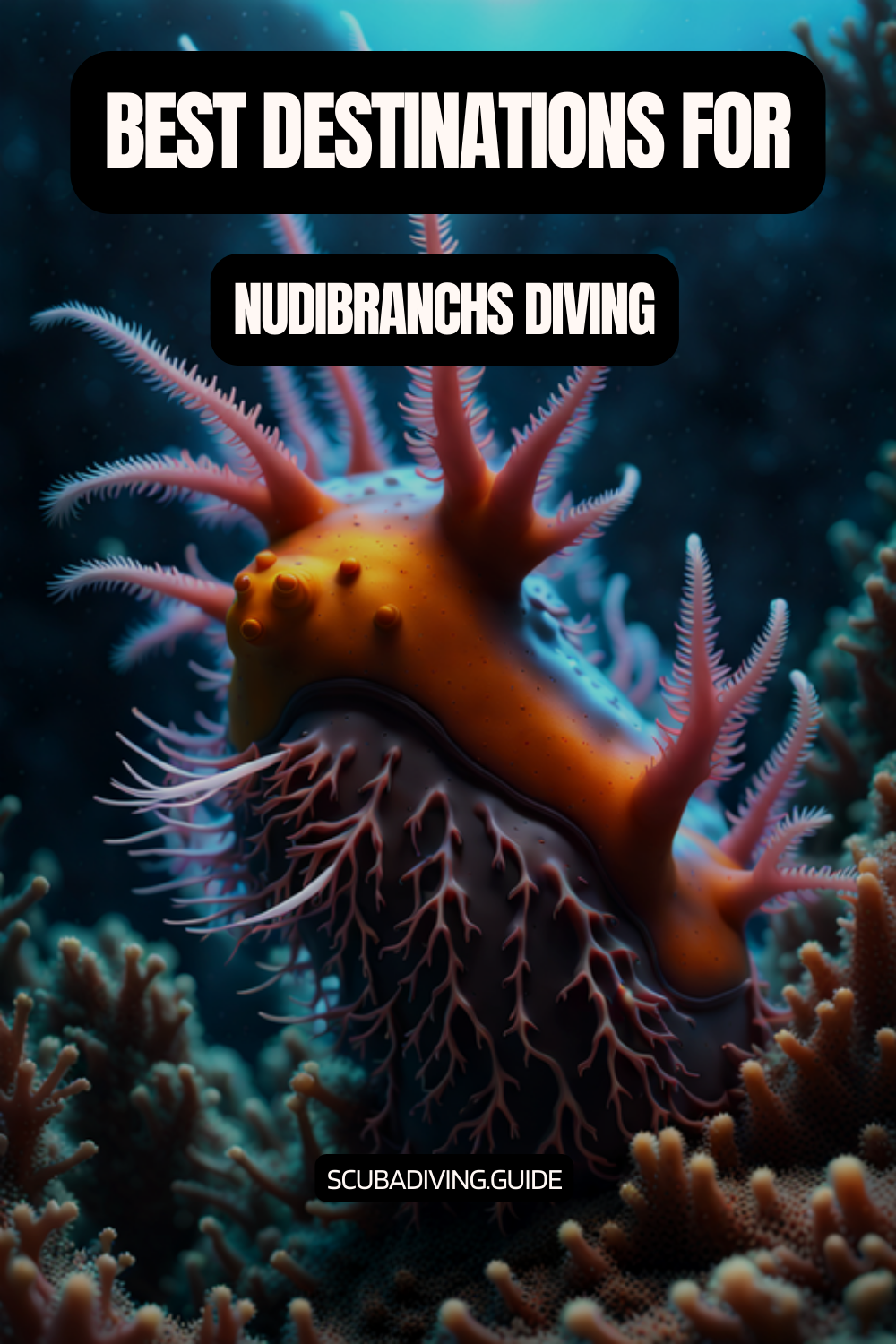
Conclusion – Diving with Nudibranchs
Diving with nudibranchs is an awe-inspiring adventure that takes you into the vibrant and captivating world of these unique sea slugs. With their stunning colors, intricate patterns, and diverse species, nudibranchs offer a mesmerizing spectacle for divers of all levels of experience.
Throughout this article, we have explored various aspects of diving with nudibranchs, from understanding their physical characteristics and behavioral patterns to learning about the essential gear and techniques required for a successful dive. We have also delved into the thrills and challenges that come with encountering nudibranchs in their natural habitats and provided a list of some of the best destinations around the world for nudibranch diving.
Diving with nudibranchs not only provides an opportunity to witness the beauty of these captivating creatures but also fosters a deeper appreciation for the intricate balance of marine ecosystems. It encourages us to be mindful of our interactions with the underwater world and to take an active role in its preservation.
As divers, it is our responsibility to approach nudibranchs and their habitats with care, ensuring minimal disturbance and adhering to responsible diving practices. By doing so, we contribute to the conservation of these delicate organisms and help maintain the health and diversity of our oceans.
Whether you are a seasoned scuba diver or a beginner exploring the underwater realm for the first time, diving with nudibranchs promises an enchanting and rewarding experience. So don your gear, embrace the wonders of the underwater world, and embark on a journey to discover the captivating beauty of nudibranchs.
As you delve into the depths and encounter these mesmerizing sea slugs, remember to observe, appreciate, and protect. By doing so, you become a steward of the marine environment, ensuring that future generations can continue to marvel at the vibrant colors and fascinating behaviors of these incredible creatures.
So, immerse yourself in the world of nudibranchs, explore their habitats, and witness the wonders that lie beneath the waves. Let these enchanting creatures spark a lifelong passion for marine exploration and inspire a commitment to the preservation of our precious oceans.
